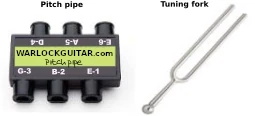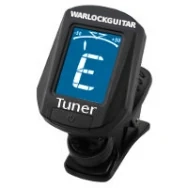Learn how to tune a guitar
Tuning a guitar is the most important thing every guitarist needs to learn and practice. It's important to always play guitar with a properly tuned instrument and it takes time to learn how to do it. Here are various methods you can use to learn how to tune the guitar to standard tuning.
Don't forget, you can use my guitar tuner while reading through this post.
What is standard tuning
Standard tuning means your guitar is tuned to E A D G B E (from lowest to highest strings). In standard tuning, the strings are tuned in intervals of a 4th (the distance apart from each other) with the exception of the 2nd string which is an interval of a 3rd apart from the 3rd string.
Standard tuning is based around the pitch of A440 which is considered concert pitch. A440 is the note A above middle C on a piano that has a frequency of 440 Hz.
Tuning using reference tones
Tuning using reference tones is one of the most common ways to tune your guitar. A reference tone is a tone played on another device or "in tune" instrument that you make your instrument match. You can use a variety of other instruments such as the human voice, guitars, pianos or devices like pitch pipes and tuning forks to get reference tones. You can even use your own guitar as long as it has at least one string in tune.

Pitch pipes work much like a whistle, you blow into the holes and the specified tone comes out. Pitch forks are struck and then they ring with whatever pitch they are.
How do you make a tone on your guitar match a reference tone?
How do you make two tones match?
This are good questions that you may have already asked yourself and which I will answer next.
Making a tone on your guitar match a reference tone requires you to develop listening skills. You can only develop these skill through practice, trial and error.
What it comes down to is this:
Sounding your reference tone while simultaneously turning your guitar's tuning key and getting rid of the WOBBLE sound. The wobble sound happens as the two sounds get closer together.
When the two tones don't match there is a wobble like sound effect between them. The closer the two tones come to each other in pitch, the stronger the wobble. When two tones are the same, they hum in a perfect synchronicity that is unmistakable. That is how you know when the two tones match.
How to tune a guitar to itself
If you have at least one string in tune (or you think it is in tune), you can use it as a reference tone just as you would from a pitch pipe or other device to tune all the other strings. If you don't have a string in tune, use a reference tone or tuner to get one (step 1) then follow the steps 2-6 below to tune the rest of the guitar strings.
Use the chart below as a guide as you follow the steps.

Tune your guitar using open strings and unisons
1 Lets pretend you don't have any strings that are tuned. Get another guitar that is in tune and pluck the A string to use as your reference tone. Tune your A string by turning your tuning key to so that the pitch of your A string matches the other guitar's A string.
Here is an A string sound you can use as a reference tone.

2 Tune the 6th string to the 5th string by pressing down the note at the 5th fret of the 6th string and simultaneously play it and the 5th string. These two notes are the same note and are called a unison. Make the pitch on the 5th fret 6th string match the pitch of the open 5th string.
3 Tune the 4th string to the 5th string by pressing down the note at the 5th fret of the 5th string and simultaneously play it and the open 4th string. Make the pitch of the 4th string match the pitch of the 5th string fretted on the 5th fret.
4 Tune the 3rd string to the 4th string by pressing down the note at the 5th fret of the 4th string and simultaneously play it and the open 3rd string. Make the pitch of the 3rd string match the pitch of the 4th string fretted on the 5th fret.
5 Tune the 2nd string to the 3rd string by pressing down the note at the 4th fret of the 3rd string and simultaneously play it and the open 2nd string. Make the pitch of the 2nd string match the pitch of the 3rd string fretted on the 4th fret. * Note: that you fret the 4th fret in this step and all other steps, fret the 5th fret.
6 Tune the 1st string to the 2nd string by pressing down the note at the 5th fret on the 2nd string and simultaneously play it and the open 1st string. Make the pitch of the 1st string match the pitch of the 2nd string fretted at the 5th fret.
Tuning with octaves at the 7th fret
Using octaves at the 7th fret for tuning is similar to the previous method of tuning the guitar to itself but uses octaves. An octave is the same pitch an order of magnitude higher. Use the octaves that occur at the 7th fret and one at the 8th on the 2nd string to tune.
This method is slightly more difficult for beginners because using octaves to tune requires you to determine the same tones but with one being an octave higher in pitch.
The note's pitch at the 7th fret (or 8th on the 2nd) is the same as the string below but one octave higher. All you have to do is make them match by removing the wobble.
Use this octave tuning chart below for a visual guide.

Electronic tuners

Electronic tuners are devices that help show you visually when the pitch of your guitar string matches a pitch name on a screen.
Using an electronic tuner feels like cheating. They make tuning your guitar easy but they don't help you develop your ear.
Using an electronic tuner basically involves playing a string and watching a screen of some sort that displays the strings current pitch. Then all you have to do is turn your guitar's tuning peg until the screen reads the correct pitch or get arrows or lines to line up. That is all there is to it. No listening required. I don't recommend tuning this way. Learn to use reference tones while learning to tune in order to better develop your ear.
What is the best electronic tuner?
Many different kinds of electronic tuners exist. There are tuners that you plug into your guitar and some that you don't. Some are integrated into amplifiers, pedals and other effects. Some like the one pictured above clip onto the guitar headstock near the tuning pegs. There are also tuner apps for your phone! All of them work about the same and which one is best is the one that is easiest for you to use.
Tuning the guitar using harmonics
I wrote another article about Harmonics on the guitar with a section about tuning the guitar using harmonics. Check it out!